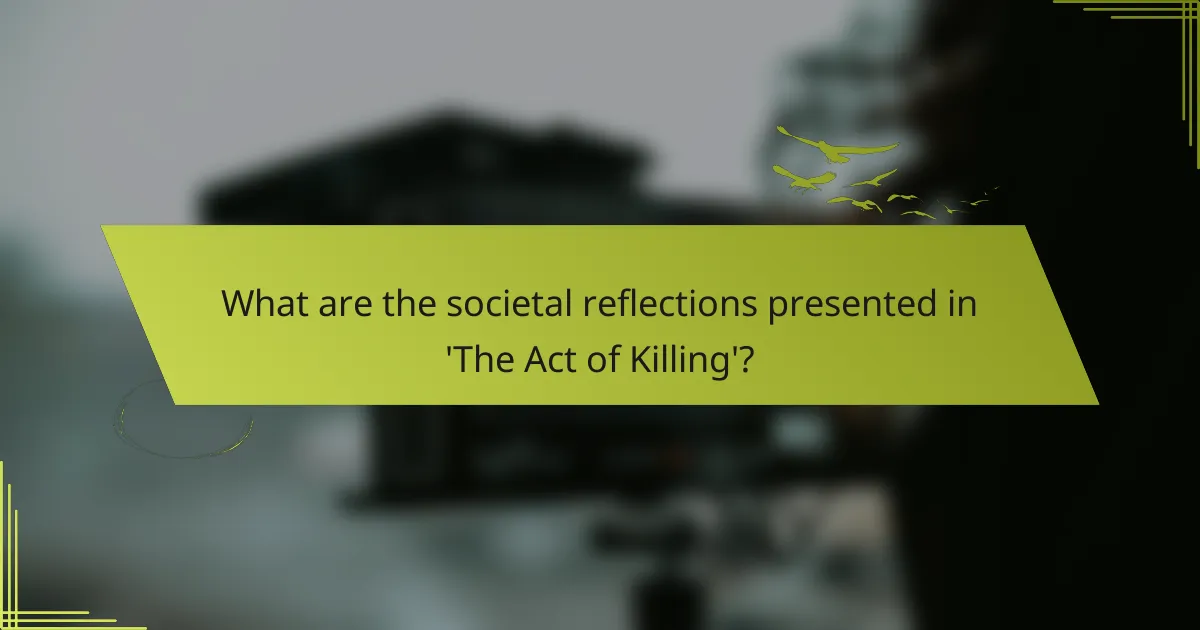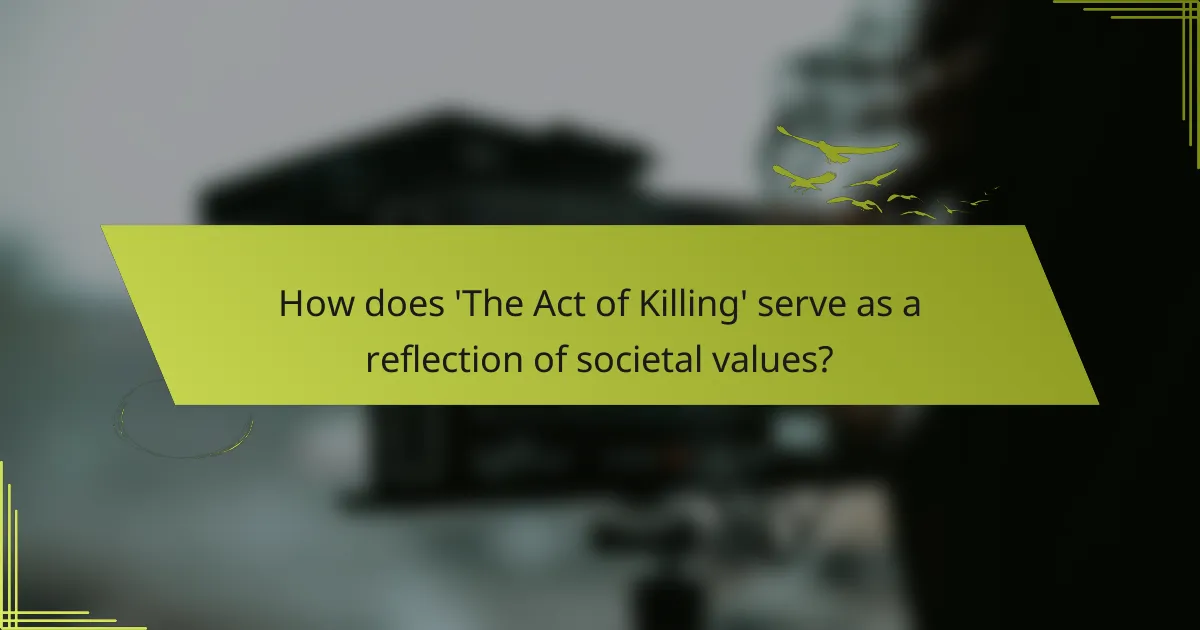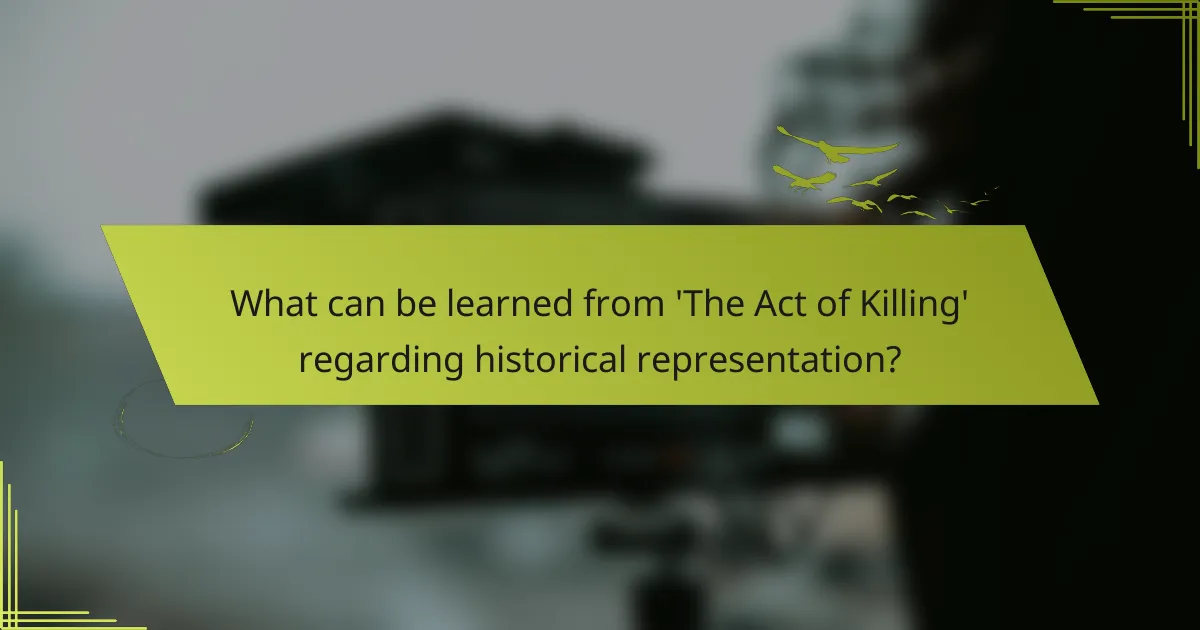
What are the societal reflections presented in ‘The Act of Killing’?
‘The Act of Killing’ presents societal reflections on the normalization of violence and impunity in Indonesia. The film showcases how perpetrators of the 1965-66 killings perceive their actions. It reveals a culture that celebrates rather than condemns these violent acts. The documentary highlights the disconnect between historical narrative and collective memory. It exposes the lack of accountability for crimes against humanity. The film prompts audiences to confront uncomfortable truths about complicity in violence. It also illustrates the impact of propaganda on societal attitudes towards justice. Overall, it serves as a critique of the moral and ethical implications of state-sponsored violence.
How does the film depict the historical context of the Indonesian mass killings?
The film depicts the historical context of the Indonesian mass killings by illustrating the events of 1965-1966 when an estimated 500,000 to 1 million people were killed. It portrays the perpetrators’ perspectives, showcasing their justifications for violence. The film uses reenactments to highlight the brutal methods employed during the killings. It emphasizes the lack of accountability and the culture of impunity that followed these events. The narrative reflects on the societal impact and trauma experienced by survivors. By blending documentary and dramatization, the film provides a visceral understanding of this dark chapter in Indonesian history. The historical context is further reinforced through interviews and personal testimonies from those involved. The film serves as a critical examination of memory and history in Indonesia.
What events led to the mass killings portrayed in the film?
The mass killings portrayed in the film were primarily a result of the Indonesian genocide that occurred in 1965-1966. This genocide was initiated by a failed coup attempt against President Sukarno. Following the coup, the military, led by General Suharto, targeted suspected communists and leftists. The government propaganda depicted these individuals as a threat to national stability. As a result, an estimated 500,000 to 1 million people were killed during this purge. The killings were characterized by extreme violence and brutality. Many perpetrators were former gangsters and military personnel. The events have had lasting impacts on Indonesian society and politics.
How does the film represent the political climate of Indonesia during this period?
The film represents the political climate of Indonesia during this period by depicting the violent anti-communist purge of the 1960s. It showcases the brutal methods used by military and paramilitary groups to eliminate perceived threats. The portrayal of perpetrators reflects the normalization of violence in Indonesian society. The film illustrates the lack of accountability for these crimes within the political system. It highlights the complicity of the government in these atrocities. The narrative reveals how the legacy of this violence continues to affect contemporary Indonesian politics. The film serves as a critique of the culture of impunity that persists in the nation. Through personal testimonies, it emphasizes the trauma experienced by victims and their families.
What ethical implications arise from the portrayal of violence in ‘The Act of Killing’?
The portrayal of violence in ‘The Act of Killing’ raises significant ethical implications regarding representation and accountability. The film depicts the real-life perpetrators of mass killings in Indonesia, which challenges the viewer’s moral stance on violence. It presents a risk of glorifying violence by allowing these individuals to recreate their actions in a cinematic format. This can desensitize audiences to the gravity of such atrocities. Furthermore, it raises questions about the ethical responsibility of filmmakers in portraying sensitive historical events. The film’s approach may inadvertently reinforce harmful narratives about impunity for violence. Additionally, it can affect the victims’ families and communities by reopening traumatic wounds. The ethical discourse surrounding this portrayal emphasizes the need for sensitivity in documenting historical violence.
How does the film challenge traditional narratives of history?
The film “The Act of Killing” challenges traditional narratives of history by presenting the perspectives of Indonesian death squad leaders. It deconstructs the glorification of violence by allowing perpetrators to reenact their crimes. This approach highlights the subjective nature of historical accounts. The film questions the moral implications of historical narratives that omit the voices of victims. By showcasing the psychological impact on the perpetrators, it reveals the complexities of guilt and denial. The use of cinematic techniques blurs the line between reality and representation. This challenges viewers to reconsider accepted historical truths. Overall, it emphasizes that history is not merely a series of events, but a narrative shaped by power dynamics.
What moral questions does the film raise about the representation of perpetrators?
The film raises significant moral questions regarding the representation of perpetrators. It challenges the audience to consider the complexities of guilt and responsibility. The portrayal of perpetrators blurs the lines between victim and aggressor. This representation can evoke empathy for individuals who commit atrocities. It questions whether artistic expression can justify or mitigate their actions. The film also prompts discussions about the nature of evil and its contextualization. By humanizing perpetrators, it raises ethical dilemmas about accountability. This approach can lead to a potential desensitization to violence in society.
How do audience reactions shape the understanding of the film’s message?
Audience reactions significantly shape the understanding of a film’s message. They provide immediate feedback on how the narrative resonates with viewers. Emotional responses can highlight the film’s impact on societal issues. For instance, in “The Act of Killing,” audience discomfort reflects the moral complexities of its subject matter. This discomfort can lead to deeper discussions about historical atrocities. Positive reactions may affirm the film’s effectiveness in conveying its themes. Conversely, negative reactions can indicate a disconnect between the film’s intentions and audience perceptions. Studies show that audience engagement often influences interpretations of a film’s message. Thus, reactions serve as a barometer for understanding the film’s broader implications.
What are some common interpretations of the film among viewers?
Common interpretations of ‘The Act of Killing’ among viewers include reflections on the nature of violence and its normalization. Many viewers see the film as a critique of how societies process historical atrocities. The portrayal of perpetrators reenacting their crimes raises questions about guilt and accountability. Audiences often interpret the film as a commentary on the desensitization to violence in media. Some viewers highlight the ethical implications of allowing killers to depict their actions. The film invites discussions on the role of memory in shaping national identity. Additionally, many see it as a challenge to conventional documentary storytelling. These interpretations are supported by audience reactions and critical analyses that emphasize its provocative nature.
How do different cultural backgrounds influence audience perceptions?
Different cultural backgrounds significantly influence audience perceptions. Cultural values shape how individuals interpret narratives and visuals. For example, collectivist cultures may prioritize community and family in their interpretations. In contrast, individualistic cultures might focus on personal stories and individual agency.
Research shows that cultural context affects emotional responses to media. A study by Matsumoto and Juang (2016) highlights that cultural norms dictate emotional expression and perception. Audiences from cultures with high power distance may view authority figures differently than those from low power distance cultures.
Additionally, cultural familiarity with historical events can alter engagement levels. Audiences familiar with the Indonesian genocide depicted in ‘The Act of Killing’ may react more intensely than those without that context. This variance in understanding can lead to diverse interpretations of the film’s ethical implications.
Thus, cultural backgrounds play a critical role in shaping how audiences perceive and react to media content.

How does ‘The Act of Killing’ serve as a reflection of societal values?
‘The Act of Killing’ reflects societal values by exposing the normalization of violence and impunity. The film showcases former Indonesian death squad leaders reenacting their killings. This reenactment reveals how society often glorifies perpetrators of violence. It highlights a collective denial of historical atrocities. The film’s portrayal of these individuals reveals a disturbing acceptance of brutality within the culture. It challenges viewers to confront uncomfortable truths about their own societies. The documentary’s impact is evident in its global discussions on morality and justice. Overall, it serves as a mirror to societal complicity in violence and historical memory.
What role does memory play in the societal reflections of the film?
Memory serves as a crucial element in the societal reflections of the film “The Act of Killing.” It shapes the narrative by highlighting the collective trauma experienced during Indonesia’s mass killings. The film utilizes memory to explore how individuals and society grapple with their past. By revisiting historical events, it prompts viewers to confront uncomfortable truths. This engagement with memory fosters a deeper understanding of the consequences of violence. The film’s portrayal of memory also critiques the processes of forgetting and denial in society. It emphasizes the importance of remembrance for healing and reconciliation. Through these themes, the film illustrates how memory influences societal identity and moral responsibility.
How does the film address the concept of collective memory in Indonesia?
The film addresses the concept of collective memory in Indonesia by depicting the 1965-66 mass killings. It showcases how these events are remembered and represented in society. The film features perpetrators who recount their actions without remorse. This portrayal highlights the normalization of violence in Indonesian history. The narrative challenges the official accounts of the genocide. It invites viewers to confront uncomfortable truths about the past. The film’s impact is profound, as it sparks discussions about memory and identity. It serves as a catalyst for healing and reflection within Indonesian society.
What impact does the film have on the remembrance of historical atrocities?
The film significantly impacts the remembrance of historical atrocities by providing a visceral representation of violence. It encourages audiences to confront the realities of past events, rather than viewing them as distant history. The documentary’s unique storytelling approach humanizes the perpetrators, which complicates the narrative of victimhood. This perspective fosters a deeper understanding of the psychological and social implications of such atrocities. Research shows that films like “The Act of Killing” can evoke emotional responses that strengthen collective memory. By blending documentary and dramatization, the film challenges viewers to reflect on moral accountability. This reflective process can lead to increased awareness and discussion about historical injustices. Ultimately, the film serves as a catalyst for remembrance and dialogue surrounding the atrocities depicted.
In what ways does the film critique contemporary society?
The film critiques contemporary society by exposing the normalization of violence and the consequences of impunity. It illustrates how perpetrators of historical atrocities remain unpunished and influential. The film highlights the disconnect between historical narratives and collective memory. It challenges viewers to confront uncomfortable truths about human nature and complicity. The portrayal of reenactments serves as a reflection on societal desensitization to violence. It raises questions about morality and the ethical implications of storytelling. The film’s stark imagery critiques the glorification of violence in media and culture. It ultimately prompts a reevaluation of societal values and historical accountability.
How does the film highlight ongoing issues related to violence and impunity?
The film highlights ongoing issues related to violence and impunity by depicting the brutal actions of Indonesian death squad leaders. It presents their stories without remorse, showcasing their impunity. The film uses reenactments to illustrate historical atrocities, emphasizing the lack of accountability for these crimes. It also portrays the societal desensitization to violence, reflecting a culture that normalizes such acts. Interviews with perpetrators reveal their justifications, further underscoring the absence of justice. This representation serves as a critique of systemic violence and the failure to address past human rights abuses. Through its narrative, the film invites viewers to confront uncomfortable truths about complicity and silence surrounding violence.
What societal changes does the film advocate for through its narrative?
The film advocates for greater awareness and acknowledgment of past atrocities. It emphasizes the need for truth and reconciliation in society. The narrative challenges viewers to confront the realities of violence and impunity. It calls for a collective responsibility to address historical injustices. The film also promotes dialogue about the consequences of such actions on future generations. By showcasing the perpetrators’ perspectives, it urges society to reflect on morality and ethics. This reflection aims to foster healing and prevent repetition of history. Thus, the film serves as a catalyst for societal change and awareness.

What can be learned from ‘The Act of Killing’ regarding historical representation?
‘The Act of Killing’ illustrates the complexities of historical representation. It demonstrates how perpetrators of violence can reshape narratives to absolve themselves. The film reveals the malleability of memory in constructing history. By reenacting their crimes, the subjects expose their psychological detachment from the past. This approach challenges traditional documentary methods. It prompts viewers to question the authenticity of historical accounts. The film also highlights the role of power in shaping narratives. Ultimately, it shows that history can be subjective and influenced by those who tell it.
How does the film contribute to discussions about historical truth?
The film “The Act of Killing” contributes to discussions about historical truth by presenting a unique perspective on the Indonesian killings of 1965-66. It allows perpetrators to reenact their crimes, revealing their justifications and the psychological impact of their actions. This approach challenges traditional narratives by showcasing the subjective nature of memory and history. The film’s use of dramatization emphasizes the complexities of truth in historical events. By blurring the lines between fact and fiction, it prompts viewers to question the reliability of historical accounts. The film’s critical reception highlights its role in fostering dialogue about historical atrocities and their representation. This engagement with history encourages audiences to reflect on the implications of storytelling in understanding truth.
What techniques does the film use to convey its message about history?
The film “The Act of Killing” uses reenactments and interviews to convey its message about history. Reenactments allow perpetrators to dramatize their past actions. This technique exposes the psychological impact of their deeds. Interviews provide personal reflections on the events. They reveal the justifications and rationalizations of those involved. The juxtaposition of these methods highlights the dissonance between memory and reality. The film’s surreal visuals enhance the emotional weight of the historical narrative. These techniques collectively challenge viewers to confront uncomfortable truths about violence and complicity in history.
How does the film’s unique storytelling approach affect its impact on viewers?
The film’s unique storytelling approach significantly enhances its impact on viewers. By blending documentary elements with dramatized reenactments, it creates a powerful emotional experience. This method immerses the audience in the psychological complexities of the perpetrators. It challenges viewers to confront uncomfortable truths about violence and complicity. The film’s structure encourages critical reflection on historical events and their implications. As a result, audiences often report feelings of discomfort and empathy. This duality of engagement fosters deeper discussions around morality and ethics. The innovative narrative style ultimately leaves a lasting impression on viewers.
What practical insights can be drawn from the film’s exploration of societal reflections?
The film’s exploration of societal reflections reveals significant insights about the nature of violence and memory. It illustrates how societies grapple with their historical traumas. The portrayal of perpetrators showcases the normalization of violence in certain contexts. This normalization affects collective memory and societal healing processes. The film encourages audiences to confront uncomfortable truths about their own histories. It highlights the importance of acknowledging past atrocities for future reconciliation. Additionally, it prompts discussions on the ethics of representation in storytelling. These insights emphasize the need for critical engagement with historical narratives.
How can educators utilize ‘The Act of Killing’ in teaching history and ethics?
Educators can utilize ‘The Act of Killing’ to teach history and ethics by facilitating discussions around the historical events depicted in the film. The film portrays the Indonesian mass killings of 1965-66, providing a real-world context for students to explore. Educators can encourage critical thinking about the moral implications of genocide and the psychology of perpetrators.
By analyzing the motivations and justifications presented in the film, students can engage in ethical debates. The documentary’s unique approach allows for an examination of historical narratives and the impact of storytelling on collective memory.
Incorporating primary sources and survivor testimonies can enhance the learning experience. This method encourages students to reflect on the consequences of violence and the importance of historical accountability. Overall, ‘The Act of Killing’ serves as a powerful tool for exploring complex themes in history and ethics.
What are best practices for discussing sensitive historical topics in a classroom setting?
Best practices for discussing sensitive historical topics in a classroom include establishing a safe environment. This ensures students feel comfortable sharing their thoughts. Teachers should provide context to the historical events being discussed. Context helps students understand the complexities involved. Encouraging open dialogue is crucial. This allows students to express differing viewpoints respectfully. Utilizing primary sources can enhance understanding. Primary sources provide firsthand accounts that enrich discussions. Teachers should be prepared to address emotional responses. Acknowledging feelings can foster a supportive atmosphere. Lastly, promoting critical thinking is essential. This encourages students to analyze and question historical narratives.
The main entity of the article is ‘The Act of Killing,’ a documentary that examines the societal reflections on violence and impunity in Indonesia, particularly related to the mass killings of 1965-66. The article outlines the historical context of these events, the ethical implications of portraying violence, and the complex audience reactions that shape the understanding of the film’s message. Key discussions include the normalization of violence, the disconnect between historical narratives and collective memory, as well as the film’s critique of contemporary societal values regarding accountability and justice. Overall, it emphasizes the importance of memory in addressing historical atrocities and fostering societal change.